How often you seen Green Birds in Tampa Florida? Birdwatching is a fascinating and rewarding hobby that allows enthusiasts to connect with nature and gain a deeper appreciation for the avian world. In the vibrant city of Tampa, Florida, this hobby takes on a unique charm thanks to the diverse birdlife that calls this region home. In particular, the green birds of Tampa stand out, captivating the hearts of both residents and visitors alike.
Different Species of Green Birds in Tampa Florida
Green birds encompass a diverse group of species, each with its own unique characteristics and habits. Let’s delve into a few notable representatives:
1. Green Parrots
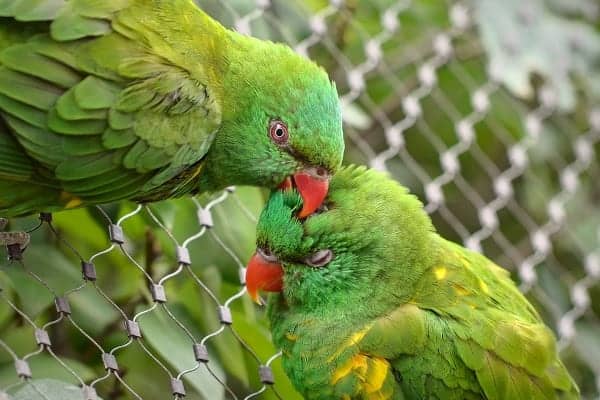
- Green parrots are renowned for their vibrant plumage, exceptional intelligence, and charismatic personalities.
- Common species include the Amazon parrot and the Eclectus parrot, known for their striking green and red coloration.
2. Green Herons
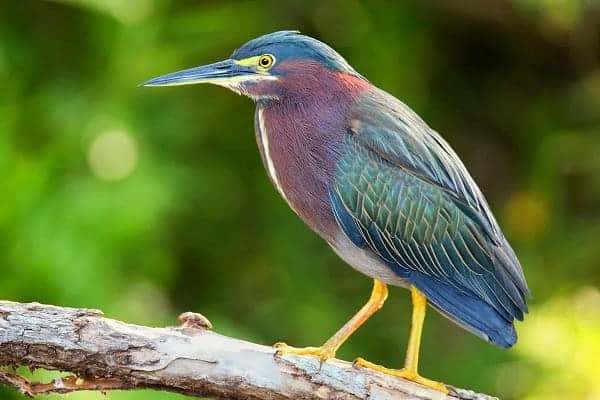
- Green herons are slender wading green birds in Tempa Florida that often lurk near water bodies, patiently waiting to catch prey.
- They are skilled hunters, using their sharp beaks and agile necks to strike at fish and aquatic insects.
- Green herons are medium-sized wading birds with striking greenish-black capes and chestnut necks.
- Habitat: They are commonly found in freshwater and brackish wetlands, where they stalk prey with remarkable patience and precision.
- Behavior: Green herons are skilled hunters, using a “bait and lure” technique to attract fish within striking distance.
3. Green Jays
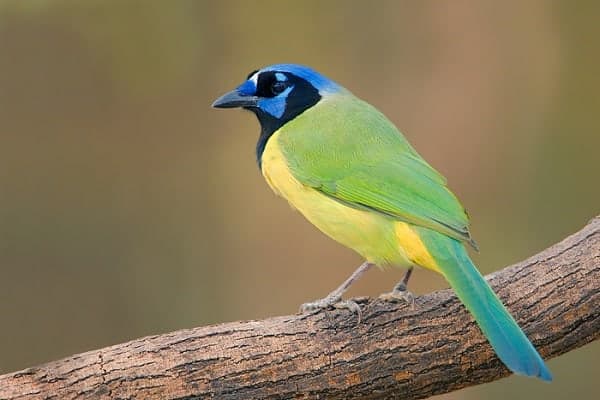
- Green jays are highly social and gregarious birds, often found in family groups.
- Their striking green and blue plumage makes them a sought-after sight in the dense forests of Central and South America.
Why Green Feathers?
The evolutionary advantage of green feathers in these birds is a subject of scientific interest and speculation. Several theories attempt to explain the prevalence of green plumage:
Camouflage
- In the lush green canopies of tropical rainforests, green plumage may offer these birds camouflage, allowing them to blend in with their surroundings and avoid predators.
Mating Signals
- Bright green feathers can serve as signals of health and vitality to potential mates, making them attractive to breeding partners.
Thermoregulation
- Green feathers may help these birds regulate their body temperature in hot and humid environments by reflecting sunlight and heat.
Species Identification
- Green plumage can aid in species identification, helping these birds recognize their own kind and avoid hybridization.
Common Green Birds in Tampa
4. Monk Parakeets
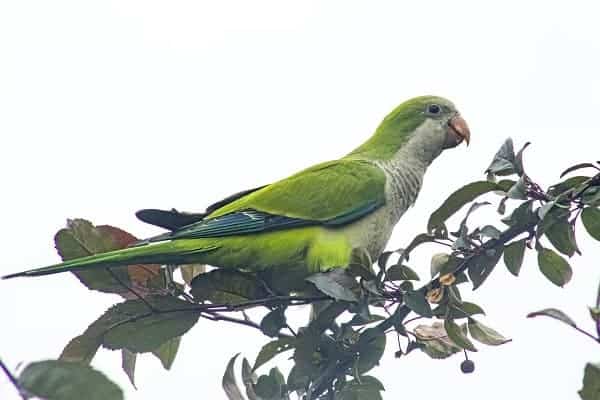
- Description: Monk parakeets, also known as Quaker parrots, are small, green parrots with distinctive gray faces and a sociable nature.
- Habitat: They have adapted well to urban environments and are often spotted nesting in large communal colonies on utility poles and trees.
- Behavior: Monk parakeets are known for their chatty, communal behavior and their remarkable nest-building skills.
5. White-Crowned Pigeons
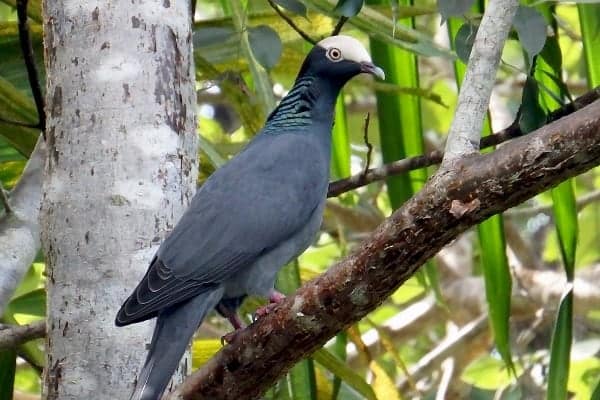
- Description: White-crowned pigeons are medium-sized pigeons with beautiful iridescent green feathers on their necks and crowns.
- Habitat: They inhabit tropical and subtropical forests, making Florida’s lush landscapes an ideal home.
- Behavior: White-crowned pigeons primarily feed on fruits and berries, playing an essential role in seed dispersal.
You May Want To Read: Yellow Birds in Michigan
Rare Green Bird Sightings
While common green birds are a delight to observe, Tampa occasionally offers sightings of rarer species that add an element of excitement to birdwatching:
6. Painted Buntings
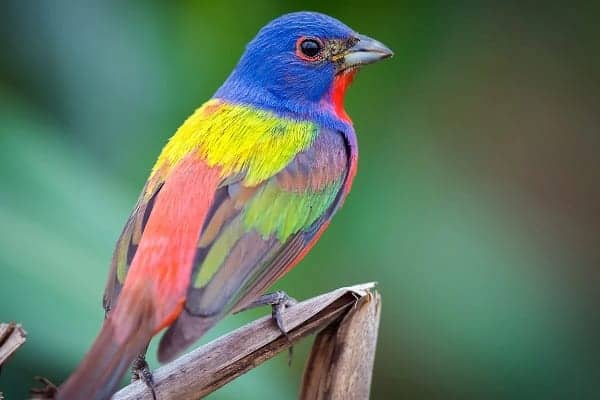
- Description: Painted buntings are small, vibrantly colored birds, with the males displaying an astonishing mix of green, blue, and red plumage.
- Sightings: These striking birds are rare visitors to Tampa, usually spotted during their spring and fall migrations.
7. Roseate Spoonbills
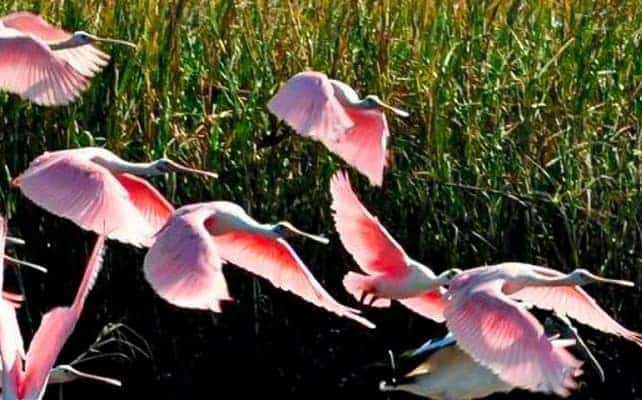
- Description: Roseate spoonbills are large wading birds known for their distinctive pink plumage and distinctive spoon-shaped bills.
- Sightings: While they aren’t green themselves, the pink hue of roseate spoonbills often contrasts beautifully with the green surroundings, making them a rare but memorable sight in Tampa’s wetlands.
Must Visit: Woodpeckers in Alabama
Bird Conservation Efforts in Tampa
Tampa’s green bird population, like many avian species worldwide, faces various challenges, including habitat loss and climate change. Fortunately, dedicated conservationists and organizations are working tirelessly to protect these feathered residents:
Habitat Restoration
- Efforts are underway to restore and conserve the natural habitats that green birds depend on, including wetlands, forests, and nesting sites.
Nesting Site Preservation
- Conservationists are actively working to protect and maintain nesting sites, especially for species like the Monk Parakeet, which build large communal nests.
Public Awareness
- Education and outreach programs aim to raise awareness about the importance of green birds and their role in Tampa’s ecosystem.
Citizen Science
- Birdwatchers and enthusiasts contribute valuable data through citizen science projects, helping researchers monitor green bird populations and behavior.
Must Read: Doves In Arkansas
The Beauty of Green Bird Calls
Unique Vocalizations
Green birds are known for their distinctive and melodious calls, each species with its own signature vocalization. These calls serve various purposes, including communication, mate attraction, and territory defense. Here are some examples:
1. Monk Parakeets
- Monk parakeets are highly vocal birds, known for their chattering and squawking sounds.
- Their communal nests often reverberate with a cacophony of social calls, creating a lively atmosphere.
2. Green Herons
- Green herons have a repertoire of calls, including a series of sharp “skeow” notes and a guttural “gok” when alarmed.
- They also engage in courtship calls during the breeding season, adding to the wetland ambiance.
3. Green Jays
- Green jays are famous for their raucous and varied vocalizations, including chattering, whistles, and mimicry of other bird species.
- Their vocal talents often make them the center of attention in Tampa’s forests.
How to Identify Green Birds by Their Calls?
Identifying green birds by their calls can be a rewarding aspect of birdwatching, especially when visual sightings are challenging. Here’s how you can learn to recognize them by sound:
1. Field Guide and Apps
- Carry a field guide or use birding apps that include audio recordings of green bird calls.
- Familiarize yourself with the unique calls of each species, paying attention to pitch, rhythm, and duration.
2. Practice and Observation
- Spend time observing green birds in their natural habitats and listen closely to their calls.
- Take notes on the context in which you hear the calls, such as mating displays or feeding activities.
3. Join Birdwatching Groups
- Join local birdwatching groups or guided tours in Tampa to learn from experienced birders.
- Birdwatching companions can help you refine your listening skills and identify calls more effectively.
Recording Green Bird Calls
Recording green bird calls can be a rewarding hobby and a valuable tool for research and documentation. Here’s how you can get started:
1. Equipment
- Invest in a good-quality digital recorder with a built-in microphone or an external microphone attachment.
- Use headphones to monitor recordings in real-time.
2. Proper Technique
- Approach birds cautiously and maintain a respectful distance to avoid disturbing them.
- Position the microphone towards the bird while minimizing background noise.
3. Record Behavior
- Capture not only the calls but also the bird’s behavior and habitat to provide context to your recordings.
- Take notes on the time of day, weather conditions, and any other relevant observations.
Frequently Asked Questions:-
1. What is the best time of day for birdwatching in Tampa?
- Early mornings and late afternoons are typically the best times for birdwatching when birds are most active and lighting is favorable for photography.
2. Are there guided birdwatching tours in Tampa?
- Yes, Tampa offers various guided birdwatching tours led by experienced birders and naturalists. Check with local nature centers and tour companies for options.
3. How can I attract green birds to my backyard?
- Plant native trees and shrubs that provide food and shelter. Offer bird feeders with appropriate seeds and maintain a clean water source.
4. Are green birds in Tampa endangered?
- While some green bird species may face threats, the conservation status varies. Consult local wildlife agencies and organizations for up-to-date information.
5. What is the legal status of keeping green birds as pets in Florida?
- The ownership of green birds as pets in Florida is subject to specific regulations and permits. Check with local authorities for legal requirements.
6. How can I report a rare green bird sighting in Tampa?
- Contact local birdwatching groups, wildlife agencies, or ornithologists to report rare bird sightings. They can help document and verify your observation.
